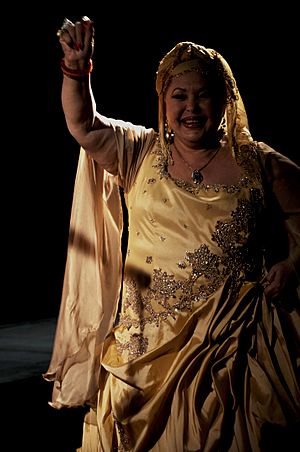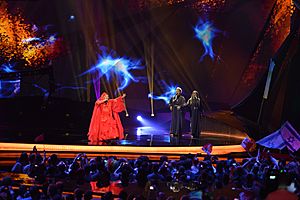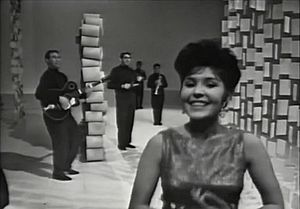Esma Redžepova facts for kids
Quick facts for kids
Esma Redžepova
|
|
|---|---|

Redžepova in 2010
|
|
| Background information | |
| Native name |
Есма Реџепова
|
| Birth name | Esma Redžepova |
| Also known as | Esma Redžepova-Teodosievska |
| Born | 8 August 1943 Skopje, Kingdom of Bulgaria |
| Died | 11 December 2016 (aged 73) Skopje, Macedonia (now North Macedonia) |
| Genres | Romani folk |
| Occupation(s) | Singer-songwriter, humanitarian |
| Instruments | vocals |
| Years active | 1956–2016 |
| Labels |
|
| Associated acts |
|
Esma Redžepova-Teodosievska (Macedonian: Есма Реџепова-Теодосиевска; 8 August 1943 – 11 December 2016) was a famous singer, songwriter, and humanitarian from Macedonia. She was a Romani artist, known for her powerful voice. People called her the "Queen of the Gypsies" because she sang hundreds of songs. She also did a lot to promote Romani culture around the world.
Esma started singing as a teenager in the 1950s. Her career lasted over 50 years. Her success was closely linked to her husband, Stevo Teodosievski. He was a composer and managed her career. Esma's music was mostly inspired by traditional Romani and Macedonian music. She also added some pop influences. When Esma began, Romani music was not respected in Yugoslavia. It was also seen as shameful for Romani women to sing in public. Esma was one of the first to sing in the Romani language on radio and TV.
Esma was known for her strong and emotional voice. In 2010, she was named one of the "50 Great Voices" in the world by NPR. She also stood out with her amazing outfits and turbans. She used common ideas about Romani women, like being joyful and expressive. In 2010, she received the Macedonian Order of Merit. In 2013, she was named National Artist of the Republic of Macedonia.
With her husband, Stevo Teodosievski, Esma fostered 47 children. She received many awards for her humanitarian work. She supported the rights of Romani people and women. She was also involved in local politics in her hometown of Skopje.
In 2013, Esma represented Macedonia in the Eurovision Song Contest 2013 with Vlatko Lozanoski. They sang "Pred da se razdeni" in Sweden. They did not make it to the final round.
Esma Redžepova passed away on December 11, 2016, after a short illness. She was 73 years old.
Contents
Esma Redžepova's Early Life
Esma Redžepova was born on August 8, 1943, in Skopje. At that time, Skopje was part of Bulgaria, but it became part of Yugoslavia in 1944. She was one of six children in a Romani family. Her family was quite diverse. Her grandfather was a Catholic Romani, and her grandmother was an Iraqi Jew. Her mother was a Muslim Romani.
Her father, Ibrahim, had lost a leg during a bombing in Skopje. He worked many jobs, like a porter or a shoeshiner. He also sang and played drums at weddings. Esma's mother was a seamstress.
When Esma was nine, her brother introduced her to a local Romani music group. She quickly learned complex rhythms. Her mother encouraged her musical talent. Esma and her brother joined their school's folk group. Her parents wanted all their children to finish primary school. However, they had traditional views. They expected Esma to marry young and become a housewife. But Esma was independent. She wore fashionable dresses instead of traditional Romani clothes.
Esma Redžepova's Music Career
How Esma Started Singing
In 1956, Esma's teacher suggested she sing at a school talent show. It was for Radio Skopje. She went without telling her parents. They did not want her to sing in public. For Romani people, singing as an unmarried girl was seen as inappropriate.
Esma sang "A bre babi sokerdžan," a traditional Macedonian Romani song. It was the first time a Romani song was played on that radio station. Esma won the contest. She beat 57 other schools and won 9,000 dinars (money). Her parents were upset when they found out. They did not want her to have a music career. At that time, Romani singers usually only performed in cafes.
Stevo Teodosievski, a Macedonian musician, was impressed by Esma. He led a large folk music group called Ansambl Teodosievski. He also worked for Radio Skopje. Teodosievski believed Romani music could become popular. At that time, Romani music was not respected in Yugoslavia. People often treated Romani people unfairly. Romani performers rarely sang in Romani on radio or TV. They often hid their background.
Teodosievski had been promoting Romani music before meeting Esma. He faced criticism for it. But he felt Esma could help him. He convinced Esma's parents to let her join his group. When they met, Teodosievski wanted Esma to improve her voice. He encouraged her to train for many hours. She also studied at the Academy of Music in Belgrade for two years.
Esma's Success in Yugoslavia
After studying, Esma joined Ansambl Teodosievski and started touring. In 1961, they went to Zagreb, Croatia. There, Esma recorded her first record. It included "A bre babi" and "Chaje Shukarije." Esma wrote "Chaje Shukarije" herself. This song, sung in Romani, quickly became a huge hit in Yugoslavia.
The 1960s and 1970s were very successful for Esma and Stevo. They recorded many albums and appeared on radio and TV. Most of Esma's songs were traditional Romani songs. Some also had Western influences. For example, "Makedo" was inspired by cha-cha-chá. "Kod Kodak" had pop influences. Esma also sang many Macedonian folk songs.
In Yugoslavia, Romani people were officially recognized. They had rights for their language and culture. But Esma was one of the few Romani artists to become widely famous.
Despite her success, Esma faced unfair treatment. Romani people in Skopje sometimes saw her as dishonorable. They criticized her relationship with Teodosievski, who was not Romani. At that time, mixed marriages were not accepted. Esma was also criticized by Romani people for her modern lifestyle. She performed on stage and traveled with men. On the other hand, institutions criticized Teodosievski for working with Romani artists. To avoid this, Esma and Teodosievski moved to Belgrade in the early 1960s. They married in 1968.
Media often described Esma using common ideas about Romani people. They said she was passionate, happy, and naturally talented. Comments were often made about her dark skin. Teodosievski used some positive ideas to promote her.
In the late 1960s, Esma and Teodosievski started a music school. They mostly trained young, disadvantaged boys, often Romani. Many musicians in Ansambl Teodosievski came from this school. In total, 48 boys attended.
Esma and Teodosievski helped other Macedonian Romani musicians. They built a circle of talented artists. These included singers Muharem Serbezovski and Usnija Redžepova.
Yugoslavia was part of the Non-Aligned Movement. This meant it was not allied with major world powers. This led to many international influences in Yugoslav art. Esma sang songs in Greek, Turkish, Hebrew, and Hindi. Romani people originally came from India. The link between Yugoslavia and India was important for Romani people. It helped their culture be recognized. Esma and Teodosievski visited India three times. In 1976, they were named the King and Queen of Romani Music. In 1983, Esma sang for Indira Gandhi, India's Prime Minister.
Esma also sang for other important leaders. These included Josip Broz Tito of Yugoslavia and Muammar Gaddafi of Libya. She performed in many countries, like the United States, Russia, and France. In 1962, she was the first Yugoslav artist to perform at the famous Olympia in Paris.
Esma's Career After Macedonia Became Independent
In the 1980s, Esma's career was at its peak. In 1989, she moved back to Skopje with her husband. After Macedonia became independent in 1991, the country faced challenges. Stevo Teodosievski passed away in 1997. The next year, Esma toured the United States, performing at charity concerts.
The 2000s were very productive for Esma. She gained a more modern image in Macedonia. She became known as a worldbeat artist. She worked with young pop singers. In 2002, she recorded a song with a Croatian band. She also sang a duet with Macedonian singer Toše Proeski. She collaborated with other bands and artists. On the international stage, she helped Romani music become popular with a wider audience. Some of her new songs were not always accepted by Western audiences. This was because they used modern instruments like the synthesizer. Esma defended her music. She said Romani music has always changed and borrowed from other styles.
Her famous song, "Chaje Shukarije," was featured in the 2006 movie Borat. Esma said the song was used without her permission. She sued the movie producers. She later won some money as compensation. It turned out the movie makers had permission from her production company, but Esma was not told. She was upset because her song was used to show something old-fashioned. This was something she always fought against. However, the movie helped her become more famous worldwide.
Esma Redžepova's Passing
Esma Redžepova passed away on the morning of December 11, 2016, in Skopje. She was 73 years old. She had been in the hospital since November 28. Her funeral was held on December 12. Many officials, including the Mayor of Skopje and the President of Macedonia, paid their respects. She was buried at Butel cemetery.
Esma Redžepova's Film Appearances
Esma Redžepova appeared in several films, both fictional stories and documentaries. She first acted in Krst Rakoc, a Yugoslav film from 1962. She also recorded four songs for its soundtrack. In 1968, she appeared as a singer in Zapej Makedonijo.
In the 2000s, Esma returned to film. She was in four documentary films. These included Im Herzen des Lichts – Die Nacht der Primadonnen (2002). She also appeared in When the Road Bends... Tales of a Gypsy Caravan (2006). This film was about five Romani music groups touring the United States. Esma was not happy with this film. She felt it showed Romani people in a negative way. She thought it made people believe all Romani people lived in poor conditions. She wanted people to know there were middle-class Romani people, like herself. In 2008, she was in Rromani Soul. This film explored the origins of Romani people. In 2009, she appeared in another German documentary, Balkan Soul & Gypsy Blues.
Esma Redžepova's Artistry
Songs and Performances
Esma Redžepova recorded over 580 songs. She earned two platinum and eight gold records. She performed more than 22,000 concerts. A third of these were for charity. With Ansambl Teodosievski, she released many singles, cassettes, and videos.
Esma mostly sang in Romani and Macedonian. But she also recorded songs in Serbo-Croatian, Turkish, Hebrew, Greek, and Hindi. Her songs often talked about love, sadness, and marriage. One of her most famous songs, "Chaje Shukarije," became an anthem for Romani people worldwide.
Esma often sang traditional songs. Many were also new compositions. Teodosievski usually composed and arranged the songs. But Esma also wrote some, like "Chaje Shukarije." She also created the dance moves for her performances.
Esma's Musical Style and Influences
Ansambl Teodosievski, with whom Esma performed most, used traditional instruments. These included the oboe, accordion, zurna, and davul. These instruments are used by both Romani and Macedonian people. Most of Esma's songs followed Romani or Macedonian folk traditions. They had influences from Turkish, Middle Eastern, and Central European music. Later, her music also showed modern influences. It became known as worldbeat pop music. In the 2000s, she sang duets with younger artists. She contributed to pop, ethno-pop, and R&B songs. Some of her earlier songs also had strong Western influences.
Esma Redžepova's voice changed over the years. When she started, her voice was bright and almost like a child's. Stevo Teodosievski compared it to a silver bell.
Esma believed Romani music was creative and always changing. She said it borrowed from many styles. However, she was critical of some mixed Romani music. She felt that Romani musicians from Spain and Hungary played more local non-Romani music. She considered her own singing style to be very old and traditional.
Esma Redžepova did not name any artists who inspired her. She said she owed everything to her husband. Her favorite artists were Nedyalka Keranova from Bulgaria and Googoosh from Iran. She also enjoyed classical music. She named Luciano Pavarotti as one of her favorite classical singers.
Videos and Stage Performances
On stage and in her music videos, Esma Redžepova used common ideas about Romani women. She wore traditional clothes and had dancers. The Middle-Eastern style of her performances was often highlighted. This was to please audiences who were not Romani. Sometimes, her costumes were not exactly like Macedonian Romani culture. For example, some videos showed Hungarian or Russian costumes. This was to match what non-Romani people expected. She also wore the Romani dimije (traditional trousers). She made them modern by using new fabrics.
Her performances could be very dramatic. This depended on the song and the feelings it brought out. For example, when singing "Hajri Ma Te Dike," Esma often wore a black veil. She would pretend to cry.
Esma worked closely with the same music group. She had a special connection with her musicians. On stage, they stood and took part in the dances. They acted out parts of the songs. In early performances, musicians swayed with their instruments. This was like Western pop groups of that time.
Museum of Music
When Esma Redžepova moved back to Skopje in 1989, she started a big project. She wanted to create a Museum of Music and House of Humanity. She and her husband imagined it as a place to keep Romani music history. It would also have musical and historical items. There would be a performance room, a studio, and a place for poor people to get medical help.
They bought land near the Contemporary Art Museum of Macedonia. Construction started in 1992. The building served as Esma's home. It was meant to become a museum after she passed away.
Humanitarian and Political Work
Esma Redžepova's first humanitarian act was fostering 47 children. This happened in the 1970s and 1980s. She also supported thousands of charity concerts. These were for hospitals, orphanages, and disaster victims. She was an honorary president of the Macedonian Red Cross. This was because of her work with Romani refugees from Kosovo. However, it was not until 2002 that she held a charity concert specifically for Romani people. Esma Redžepova was also a member of the Lions Club.
In general, she preferred to support big causes that helped everyone. She was very proud of Macedonia. She was a national icon, popular with all ethnic groups. She often showed strong patriotism. She was officially seen as a cultural ambassador. She was given a diplomatic passport in 2007. She supported the policies for Romani people in Macedonia. She said it was the best country for Romani people. They had more rights and freedom there than anywhere else. She also promoted understanding between different cultures and peace. She supported women's rights and their access to power. In 1995, she sponsored a Romani women's organization in Skopje. They chose to name themselves "Esma."
Esma Redžepova became involved in politics in the 1990s. She was close to Romani leader Amdi Bajram. She also supported Vasil Tupurkovski, who started the Democratic Alternative party. This party did not last long. Esma then joined the right-wing VMRO-DPMNE party. This party came to power in 2006. In 2009, Esma was elected to the City Council of Skopje. She was reelected in 2013.
Esma Redžepova's ties with the VMRO-DPMNE party were sometimes criticized. For example, in 2010, she received money for her museum from the City Council. The opposition party was against this. They said the museum was not officially registered. They also said the building was Esma's house and hosted a local VMRO-DPMNE office. When she was named National Artist in 2013, the opposition again criticized her. They said she also received a national pension. Finally, in the same year, her Eurovision song "Imperija" caused debate. Some thought it promoted a city development project led by the VMRO-DPMNE.
Esma Redžepova's Personal Life
Esma Redžepova married her manager, Stevo Teodosievski, in 1968. He was 19 years older than her. He passed away in 1997. They never had their own children. But they fostered 47 abandoned or needy children. They raised 5 of them in their home. They made sure all the children had a home and an education.
Esma Redžepova was known for her unique fashion style. She often wore heavy jewelry and colorful turbans. She had a collection of over 300 turbans.
Awards and Recognition for Esma Redžepova
- 1976 – Queen of World Gipsy music
- 1992 – 13 November Award of Skopje
- 1995 – Award prima donna of European singing
- 2005 – Norwegian Academy of Literature and Freedom of Expression
- 2010 – Order of Merit for Macedonia
- 2013 – National Artist of Macedonia
Discography
- Songs of a Macedonian Gypsy, World Connection, 1998
- Romske pesme, PGP-RTS, 2000
- Mon histoire, My story, Accords croisés, 2007
Filmography
- Krst Rakoc (1962)
- Zapej Makedonijo (1968)
- Jugovizija (1971)
- Im Herzen des Lichts – Die Nacht der Primadonnen (2002)
- When the Road Bends: Tales of a Gypsy Caravan (2006)
- Rromani Soul (2008)
See also
 In Spanish: Esma Redžepova para niños
In Spanish: Esma Redžepova para niños




